Michael T. Klare calls attention to the statements coming out of the U.S. Department of Defense and the upper ranks of Congress these days.
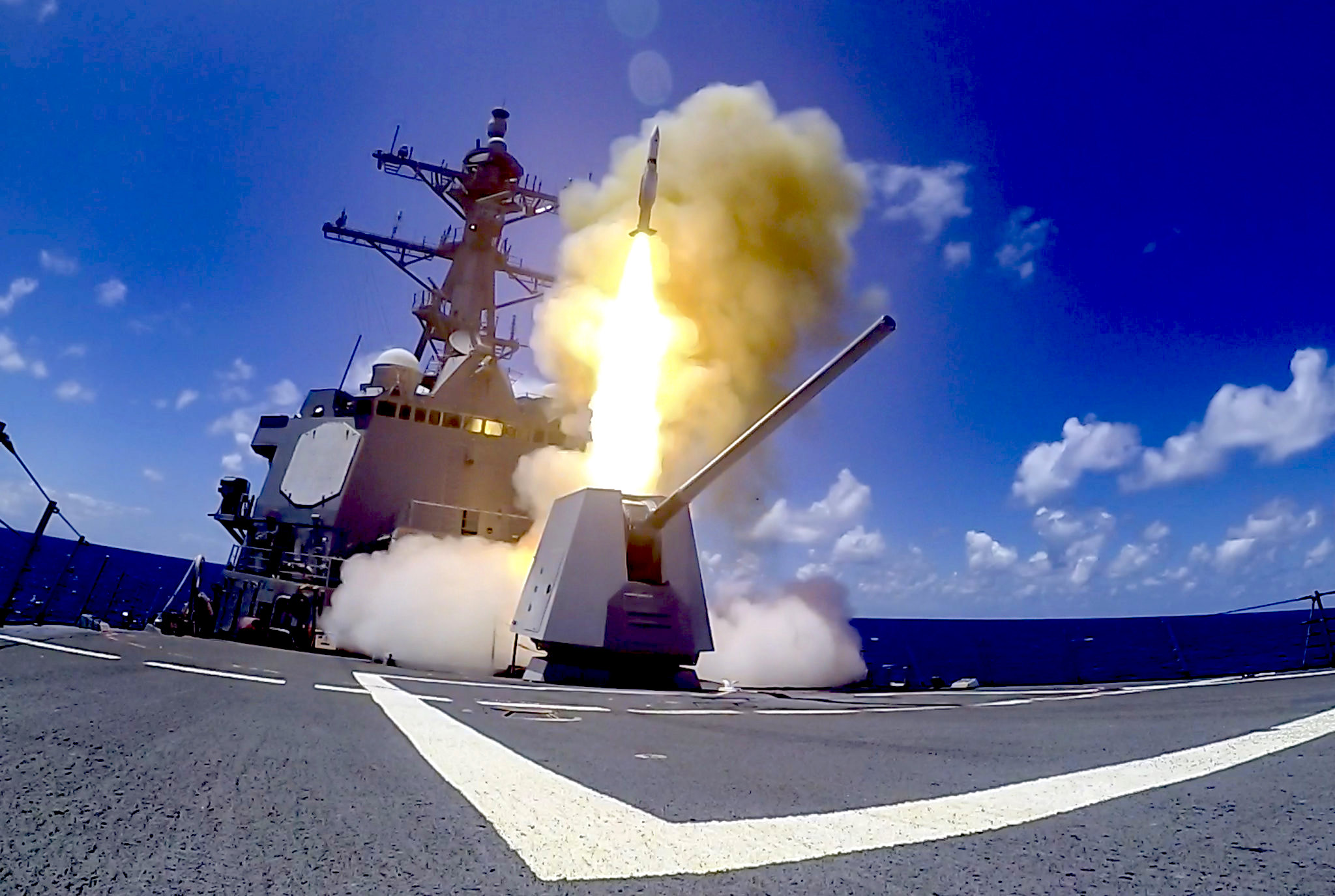
Aug. 26, 2020: Guided-missile destroyer USS Chung-Hoon launches an SM-2 missile during multi-nation Rim of the Pacific military exercises in the Pacific Ocean. (U.S. Navy, Devin M. Langer)
By Michael T. Klare
TomDispatch.com
 It’s the summer of 2026, five years after the Biden administration identified the People’s Republic of China as the principal threat to U.S. security and Congress passed a raft of laws mandating a society-wide mobilization to ensure permanent U.S. domination of the Asia-Pacific region. Although major armed conflict between the United States and China has not yet broken out, numerous crises have erupted in the western Pacific and the two countries are constantly poised for war. International diplomacy has largely broken down, with talks over climate change, pandemic relief, and nuclear nonproliferation at a standstill. For most security analysts, it’s not a matter of if a U.S.-China war will erupt, but when.
It’s the summer of 2026, five years after the Biden administration identified the People’s Republic of China as the principal threat to U.S. security and Congress passed a raft of laws mandating a society-wide mobilization to ensure permanent U.S. domination of the Asia-Pacific region. Although major armed conflict between the United States and China has not yet broken out, numerous crises have erupted in the western Pacific and the two countries are constantly poised for war. International diplomacy has largely broken down, with talks over climate change, pandemic relief, and nuclear nonproliferation at a standstill. For most security analysts, it’s not a matter of if a U.S.-China war will erupt, but when.
Does this sound fanciful? Not if you read the statements coming out of the Department of Defense (DoD) and the upper ranks of Congress these days.
“China poses the greatest long-term challenge to the United States and strengthening deterrence against China will require DoD to work in concert with other instruments of national power,” the Pentagon’s 2022 Defense Budget Overview asserts. “A combat-credible Joint Force will underpin a whole-of-nation approach to competition and ensure the Nation leads from a position of strength.”
On this basis, the Pentagon requested $715 billion in military expenditures for 2022, with a significant chunk of those funds to be spent on the procurement of advanced ships, planes, and missiles intended for a potential all-out, “high-intensity” war with China. An extra $38 billion was sought for the design and production of nuclear weapons, another key aspect of the drive to overpower China.
Democrats and Republicans in Congress, contending that even such sums were insufficient to ensure continued U.S. superiority vis-à-vis that country, are pressing for further increases in the 2022 Pentagon budget. Many have also endorsed the EAGLE Act, short for Ensuring American Global Leadership and Engagement — a measure intended to provide hundreds of billions of dollars for increased military aid to America’s Asian allies and for research on advanced technologies deemed essential for any future high-tech arms race with China.
Imagine, then, that such trends only gain momentum over the next five years. What will this country be like in 2026? What can we expect from an intensifying new Cold War with China that, by then, could be on the verge of turning hot?
Taiwan 2026: Perpetually on the Brink
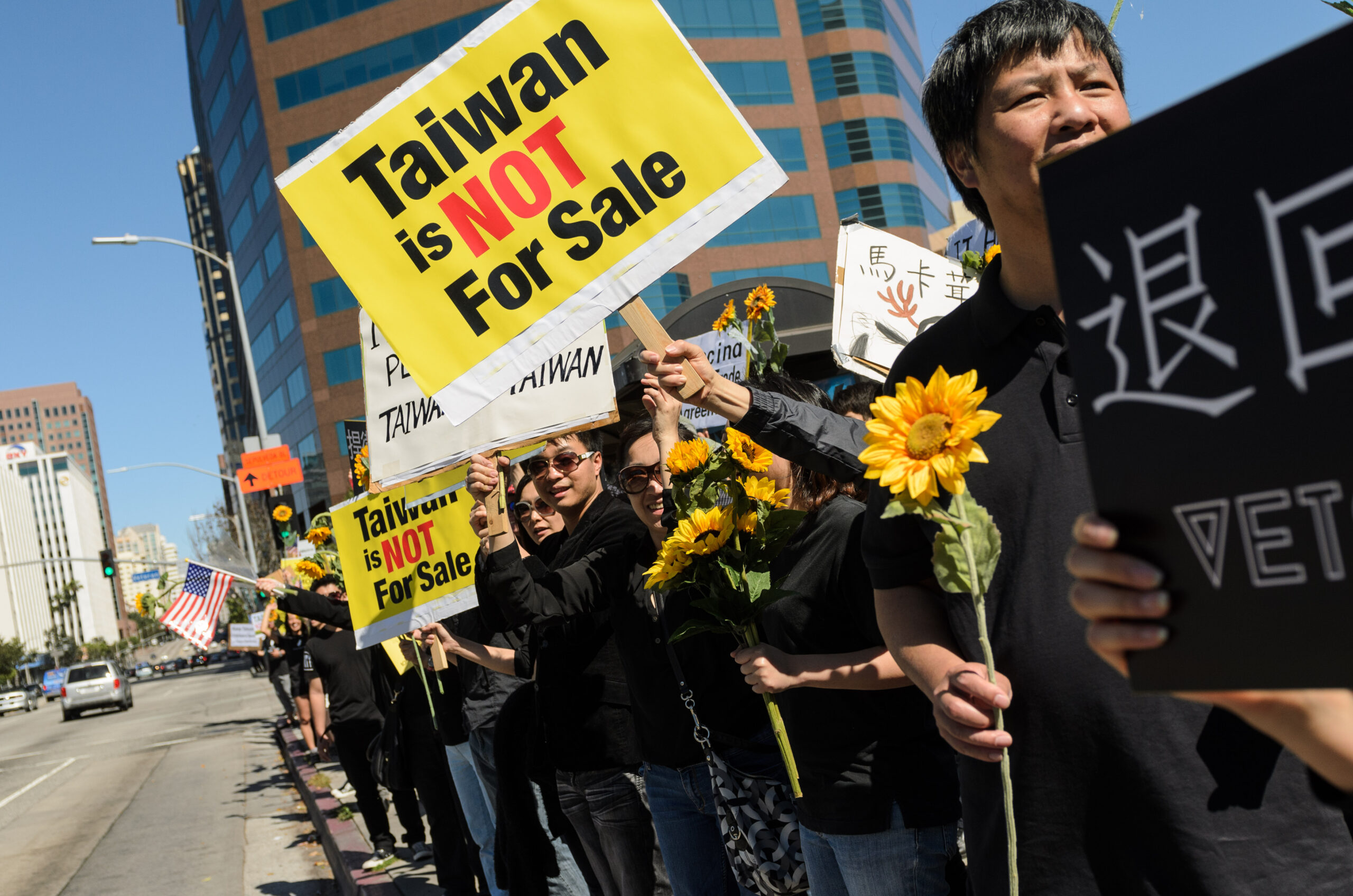
Feb. 30, 2014: Supporters of the Taiwanese Sunflower Movement demonstrating in Los Angeles against a trade pact agreement with China. (Neon Tommy – Flickr, CC BY-SA 2.0, Wikimedia Commons)
Crises over Taiwan have erupted on a periodic basis since the start of the decade, but now, in 2026, they seem to be occurring every other week. With Chinese bombers and warships constantly probing Taiwan’s outer defenses and U.S. naval vessels regularly maneuvering close to their Chinese counterparts in waters near the island, the two sides never seem far from a shooting incident that would have instantaneous escalatory implications. So far, no lives have been lost, but planes and ships from both sides have narrowly missed colliding again and again. On each occasion, forces on both sides have been placed on high alert, causing jitters around the world.
The tensions over that island have largely stemmed from incremental efforts by Taiwanese leaders, mostly officials of the Democratic Progressive Party (DPP), to move their country from autonomous status as part of China to full independence. Such a move is bound to provoke a harsh, possibly military response from Beijing, which considers the island a renegade province.
The island’s status has plagued U.S.-China relations for decades. When, on Jan. 1, 1979, Washington first recognized the People’s Republic of China, it agreed to withdraw diplomatic recognition from the Taiwanese government and cease formal relations with its officials.
Under the Taiwan Relations Act of 1979, however, U.S. officials were obligated to conduct informal relations with Taipei. The act stipulated as well that any move by Beijing to alter Taiwan’s status by force would be considered “a threat to the peace and security of the Western Pacific area and of grave concern to the United States” — a stance known as “strategic ambiguity,” as it neither guaranteed American intervention, nor ruled it out.
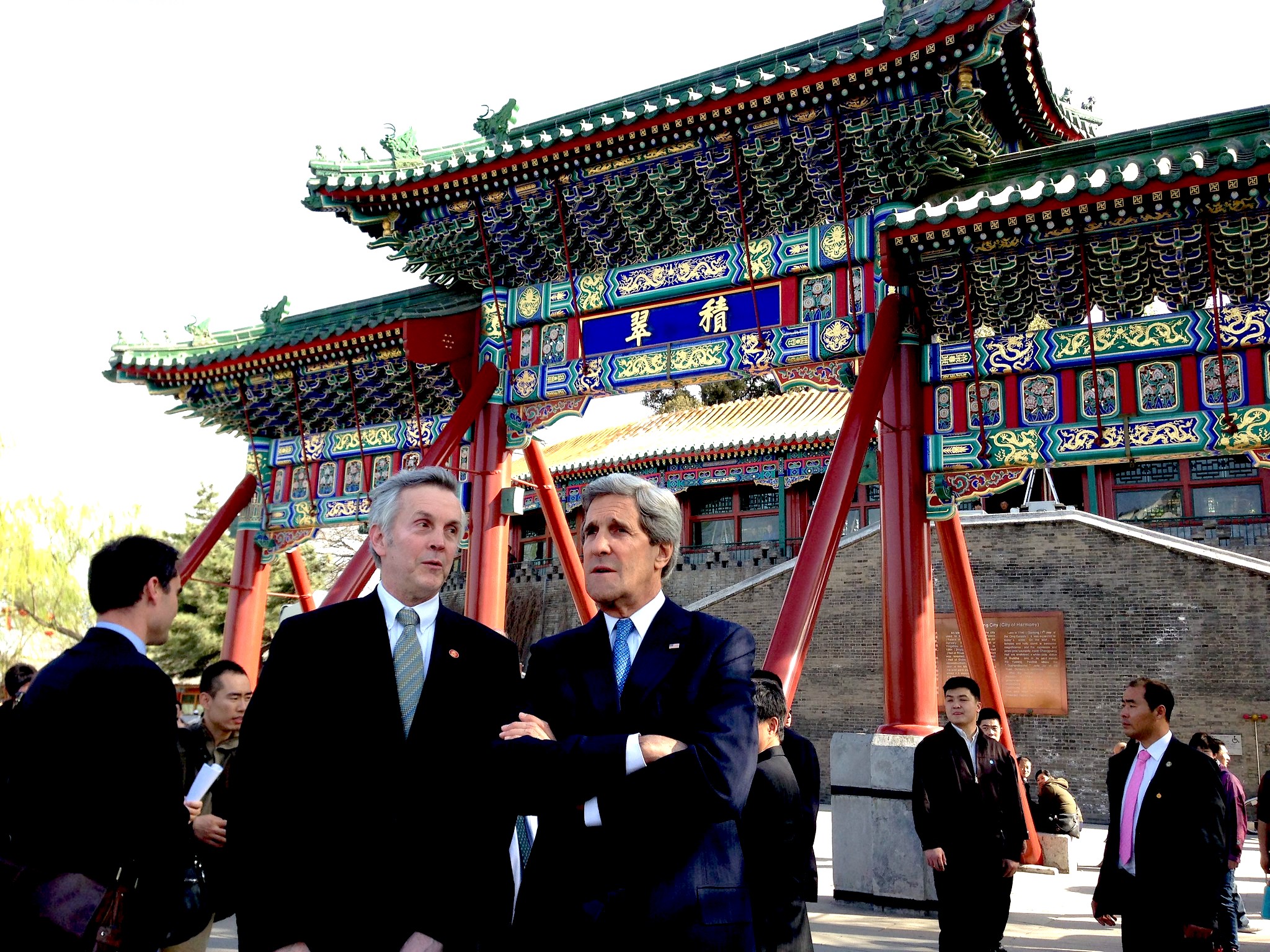
April 13, 2013: U.S. Secretary of State John Kerry, at right, with longtime Chinese translator James Brown, in Beijing’s Beihai Park. (State Department, Alison Anzalone)
In the ensuing decades, the U.S. sought to avoid conflict in the region by persuading Taipei not to make any overt moves toward independence and by minimizing its ties to the island, thereby discouraging aggressive moves by China.
By 2021, however, the situation had been remarkably transformed. Once under the exclusive control of the Nationalist Party that had been defeated by communist forces on the Chinese mainland in 1949, Taiwan became a multiparty democracy in 1987. It has since witnessed the steady rise of pro-independence forces, led by the DPP.
At first, the mainland regime sought to woo the Taiwanese with abundant trade and tourism opportunities, but the excessive authoritarianism of its Communist Party alienated many island residents — especially younger ones — only adding momentum to the drive for independence. This, in turn, has prompted Beijing to switch tactics from courtship to coercion by constantly sending its combat planes and ships into Taiwanese air and sea space.
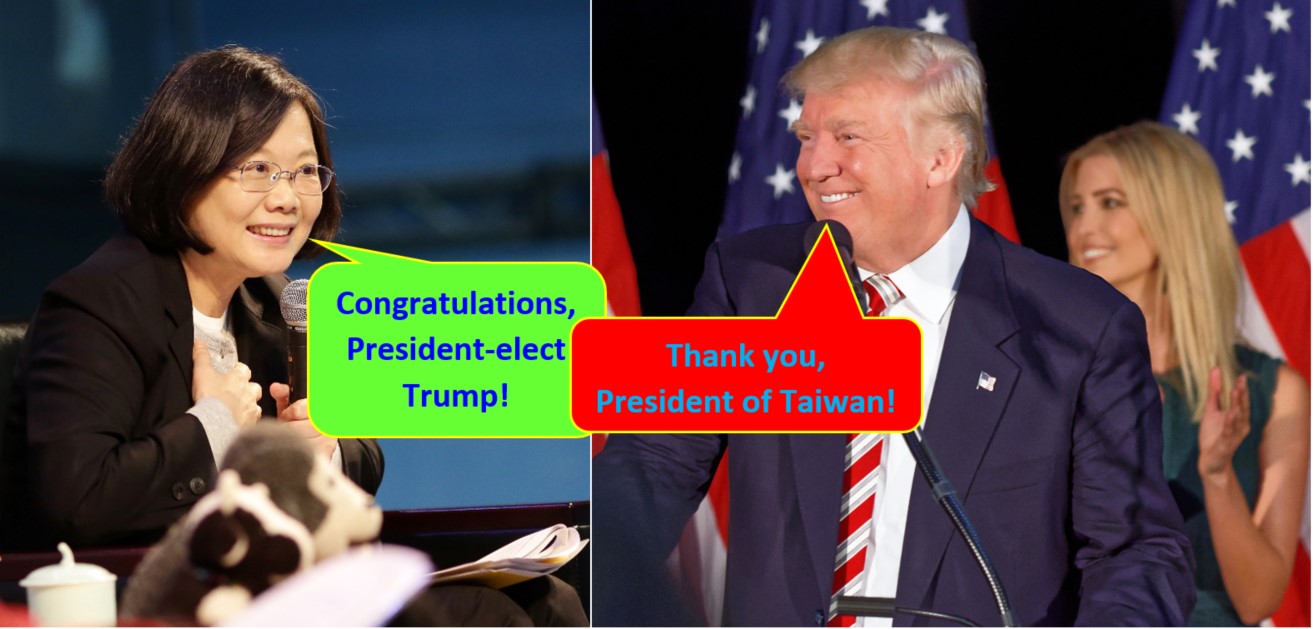
Cartoon depiction of then U.S. President-elect Donald Trump speaking with Republic of China President Tsai Ing-wen in a Dec. 2, 2016, phone call that marked the first time since 1979 that a U.S. president or president-elect had directly spoken with an ROC president. (Wildcursive, CC BY-SA 4.0, Wikimedia Commons)
Trump administration officials, less concerned about alienating Beijing than their predecessors, sought to bolster ties with the Taiwanese government in a series of gestures that Beijing found threatening and that were only expanded in the early months of the Biden administration. At that time, growing hostility to China led many in Washington to call for an end to “strategic ambiguity” and the adoption of an unequivocal pledge to defend Taiwan if it were to come under attack from the mainland.
“I think the time has come to be clear,” Senator Tom Cotton of Arkansas declared in February 2021. “Replace strategic ambiguity with strategic clarity that the United States will come to the aid of Taiwan if China was to forcefully invade Taiwan.”
The Biden administration was initially reluctant to adopt such an inflammatory stance, since it meant that any conflict between China and Taiwan would automatically become a U.S.-China war with nuclear ramifications.
In April 2021, however, under intense congressional pressure, the Biden administration formally abandoned “strategic ambiguity” and vowed that a Chinese invasion of Taiwan would prompt an immediate American military response. “We will never allow Taiwan to be subjugated by military force,” President Joe Biden declared at that time, a striking change in a longstanding American strategic position.
The DoD would soon announce the deployment of a permanent naval squadron to the waters surrounding Taiwan, including an aircraft carrier and a supporting flotilla of cruisers, destroyers, and submarines. Ely Ratner, Biden’s top envoy for the Asia-Pacific region, first outlined plans for such a force in June 2021 during testimony before the Senate Armed Services Committee.
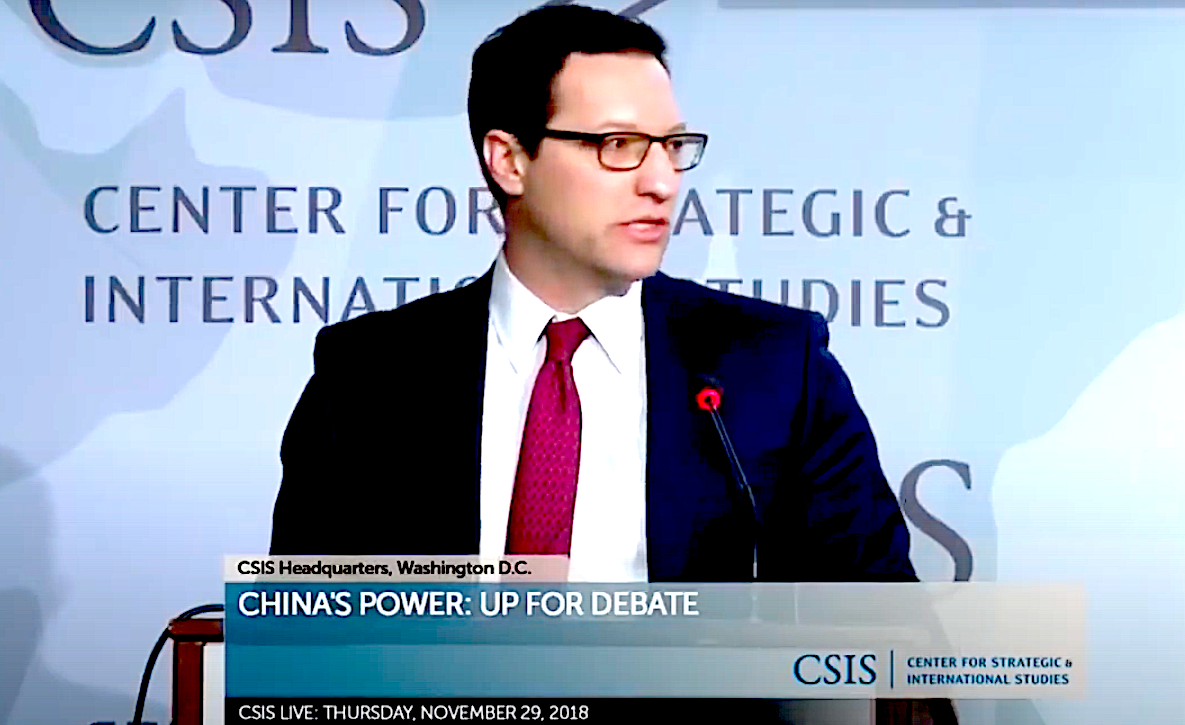
Dec 6, 2018: Ely Ratner, then with the Center for a New American Security, shown arguing for a change in U.S. engagement with China at a debate hosted by the Center for Strategic International Studies. (YouTube still)
A permanent U.S. presence, he suggested, would serve to “deter, and, if necessary, deny a fait accompli scenario” in which Chinese forces quickly attempted to overwhelm Taiwan. Although described as tentative then, it would, in fact, become formal policy following Biden’s April 2022 declaration on Taiwan and a brief exchange of warning shots between a Chinese destroyer and a U.S. cruiser just south of the Taiwan Strait.
Today, in 2026, with a U.S. naval squadron constantly sailing in waters near Taiwan and Chinese ships and planes constantly menacing the island’s outer defenses, a potential Sino-American military clash never seems far off.
Should that occur, what would happen is impossible to predict, but most analysts now assume that both sides would immediately fire their advanced missiles — many of them hypersonic (that is, exceeding five times the speed of sound) — at their opponent’s key bases and facilities. This, in turn, would provoke further rounds of air and missile strikes, probably involving attacks on Chinese and Taiwanese cities as well as U.S. bases in Japan, Okinawa, South Korea, and Guam. Whether such a conflict could be contained at the non-nuclear level remains anyone’s guess.

U.S. Sen. Tom Cotton, at left, during a 2015 visit to a Patriot missile tactical site at Osan Air Base, Korea. (William Leasure, Wikimedia Commons)
The Incremental Draft
In the meantime, planning for a U.S.-China war-to-come has dramatically reshaped American society and institutions. The “Forever Wars” of the first two decades of the 21st century had been fought entirely by an All-Volunteer Force (AVF) that typically endured multiple tours of duty, in particular in Iraq and Afghanistan. The U.S. was able to sustain such combat operations (while continuing to maintain a substantial troop presence in Europe, Japan and South Korea) with 1.4 million servicemembers because American forces enjoyed uncontested control of the airspace over its war zones, while China and Russia remained wary of engaging U.S. forces in their own neighborhoods.
Today, in 2026, however, the picture looks radically different: China, with an active combat force of 2 million soldiers, and Russia, with another million — both militaries equipped with advanced weaponry not widely available to them in the early years of the century — pose a far more formidable threat to U.S. forces. An AVF no longer looks particularly viable, so plans for its replacement with various forms of conscription are already being put into place.
Bear in mind, however, that in a future war with China and/or Russia, the Pentagon doesn’t envision large-scale ground battles reminiscent of World War II or the Iraq invasion of 2003. Instead, it expects a series of high-tech battles involving large numbers of ships, planes, and missiles. This, in turn, limits the need for vast conglomerations of ground troops, or “grunts,” as they were once labeled, but increases the need for sailors, pilots, missile launchers, and the kinds of technicians who can keep so many high-tech systems at top operational capacity.

Standing watch over the optical-sighting-system in the combat information center as the guided missile destroyer USS Mustin conducts routine operations in the Taiwan Strait, Aug. 18, 2020. (U.S. Navy, Cody Beam)
As early as October 2020, during the final months of the Trump administration, Secretary of Defense Mark Esper was already calling for a doubling of the size of the U.S. naval fleet, from approximately 250 to 500 combat vessels, to meet the rising threat from China. Clearly, however, there would be no way for a force geared to a 250-ship navy to sustain one double that size. Even if some of the additional ships were “uncrewed,” or robotic, the Navy would still have to recruit several hundred thousand more sailors and technicians to supplement the 330,000 then in the force. Much the same could be said of the U.S. Air Force.
Back to the Future ….
No surprise, then, that an incremental restoration of the draft, abandoned in 1973 as the Vietnam War was drawing to a close, has taken place in these years.
In 2022, Congress passed the National Service Reconstitution Act (NSRA), which requires all men and women aged 18 to 25 to register with newly reconstituted National Service Centers and to provide them with information on their residence, employment status, and educational background — information they are required to update on an annual basis.
In 2023, the NSRA was amended to require registrants to complete an additional questionnaire on their technical, computer, and language skills.
Since 2024, all men and women enrolled in computer science and related programs at federally aided colleges and universities have been required to enroll in the National Digital Reserve Corps (NDRC) and spend their summers working on defense-related programs at selected military installations and headquarters. Members of that Digital Corps must also be available on short notice for deployment to such facilities, should a conflict of any sort threaten to break out.

Recruiter with an attendee of the Military Exploration Workshop at Columbine High School in Littleton, Colorado, March 21, 2017. (DoD/Benjamin Pryer)
(The establishment of just such a corps, it should be noted, had been a recommendation of the National Security Commission on Artificial Intelligence, a federal agency established in 2019 to advise Congress and the White House on how to prepare the nation for a high-tech arms race with China. “We must win the AI competition that is intensifying strategic competition with China,” the commission avowed in March 2021, given that “the human talent deficit is the government’s most conspicuous AI deficit.” To overcome it, the commission suggested then, “We should establish a… civilian National Reserve to grow tech talent with the same seriousness of purpose that we grow military officers. The digital age demands a digital corps.”)
Indeed, only five years later, with the prospect of a U.S.-China conflict so obviously on the agenda, Congress is considering a host of bills aimed at supplementing the Digital Corps with other mandatory service requirements for men and women with technical skills, or simply for the reinstatement of conscription altogether and the full-scale mobilization of the nation. Needless to say, protests against such measures have been erupting at many colleges and universities, but with the mood of the country becoming increasingly bellicose, there has been little support for them among the general public. Clearly, the “volunteer” military is about to become an artifact of a previous epoch.
With the White House, Congress and the Pentagon obsessively focused on preparations for what’s increasingly seen as an inevitable war with China, it’s hardly surprising that civil society in 2026 has similarly been swept up in an increasingly militaristic anti-China spirit.
Popular culture is now saturated with nationalistic and jingoistic memes, regularly portraying China and the Chinese leadership in derogatory, often racist terms. Domestic manufacturers hype “Made in America” labels (even if they’re often inaccurate) and firms that once traded extensively with China loudly proclaim their withdrawal from that market, while the streaming superhero movie of the moment, The Beijing Conspiracy, on a foiled Chinese plot to disable the entire U.S. electrical grid, is the leading candidate for the best film Oscar.
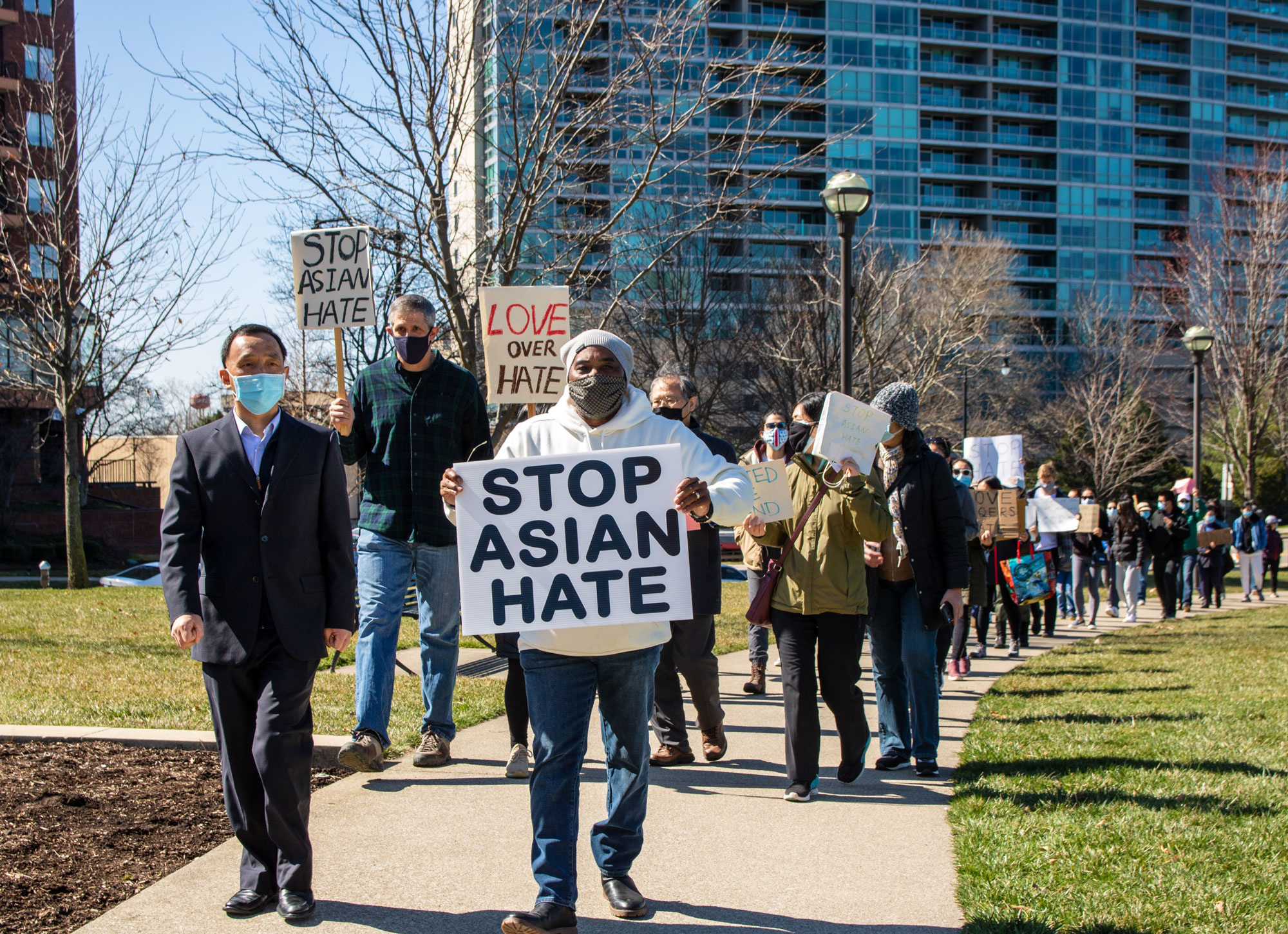
Demonstration against Asian hate crimes in Columbus, Ohio, March 20, 2021. (Becker1999, CC BY 2.0, Wikipedia Commons)
Domestically, by far the most conspicuous and pernicious result of all this has been a sharp rise in hate crimes against Asian Americans, especially those assumed to be Chinese, whatever their origin. This disturbing phenomenon, which began at the outset of the Covid crisis, when President Donald Trump, in a transparent effort to deflect blame for his mishandling of the pandemic, started using terms like “Chinese Virus” and “Kung Flu” to describe the disease.
Attacks on Asian Americans rose precipitously then and continued to climb after Joe Biden took office and began vilifying Beijing for its human rights abuses in Xinjiang and Hong Kong. According to the watchdog group Stop AAPI Hate, some 6,600 anti-Asian incidents were reported in the U.S. between March 2020 and March 2021, with almost 40 percent of those events occurring in February and March 2021.
For observers of such incidents back then, the connection between anti-China policymaking at the national level and anti-Asian violence at the neighborhood level was incontrovertible. “When America China-bashes, then Chinese get bashed, and so do those who ‘look Chinese,’” said Russell Jeung, a professor of Asian American Studies at San Francisco State University at that time. “American foreign policy in Asia is American domestic policy for Asians.”
By 2026, most Chinatowns in America have been boarded up and those that remain open are heavily guarded by armed police. Most stores owned by Asian Americans (of whatever background) were long ago closed due to boycotts and vandalism, and Asian Americans think twice before leaving their homes.
The hostility and distrust exhibited toward Asian Americans at the neighborhood level has been replicated at the workplace and on university campuses, where Chinese Americans and Chinese-born citizens are now prohibited from working at laboratories in any technical field with military applications. Meanwhile, scholars of any background working on China-related topics are subject to close scrutiny by their employers and government officials. Anyone expressing positive comments about China or its government is routinely subjected to harassment, at best, or at worst, dismissal and FBI investigation.
As with the incremental draft, such increasingly restrictive measures were first adopted in a series of laws in 2022. But the foundation for much of this was the United States Innovation and Competition Act of 2021, passed by the Senate in June of that year. Among other provisions, it barred federal funding to any college or university that hosted a Confucius Institute, a Chinese government program to promote that country’s language and culture in foreign countries. It also empowered federal agencies to coordinate with university officials to “promote protection of controlled information as appropriate and strengthen defense against foreign intelligence services,” especially Chinese ones.
In Reality …
Yes, in reality, we’re still in 2021, even if the Biden administration regularly cites China as our greatest threat. Naval incidents with that country’s vessels in the South China Sea and the Taiwan Strait are indeed on the rise, as are anti-Asian-American sentiments domestically. Meanwhile, as the planet’s two greatest greenhouse-gas emitters squabble, our world is growing hotter by the year.
Without question, something like the developments described above (and possibly far worse) will lie in our future unless action is taken to alter the path we’re now on.
All of those “2026” developments, after all, are rooted in trends and actions already under way that only appear to be gathering momentum at this moment. Bills like the Innovation and Competition Act enjoy near unanimous support among Democrats and Republicans, while strong majorities in both parties favor increased funding of Pentagon spending on China-oriented weaponry. With few exceptions — Sen. Bernie Sanders among them — no one in the upper ranks of government is saying: Slow down. Don’t launch another Cold War that could easily go hot.
“It is distressing and dangerous,” as Sanders wrote recently in Foreign Affairs, “that a fast-growing consensus is emerging in Washington that views the U.S.-Chinese relationship as a zero-sum economic and military struggle.” At a time when this planet faces ever more severe challenges from climate change, pandemics, and economic inequality, he added that “the prevalence of this view will create a political environment in which the cooperation that the world desperately needs will be increasingly difficult to achieve.”
In other words, we Americans face an existential choice: Do we stand aside and allow the “fast-growing consensus” Sanders speaks of to shape national policy, while abandoning any hope of genuine progress on climate change or those other perils? Alternately, do we begin trying to exert pressure on Washington to adopt a more balanced relationship with China, one that would place at least as much emphasis on cooperation as on confrontation. If we fail at this, be prepared in 2026 or soon thereafter for the imminent onset of a catastrophic (possibly even nuclear) U.S.-China war.
Michael T. Klare, a TomDispatch regular, is the five-college professor emeritus of peace and world security studies at Hampshire College and a senior visiting fellow at the Arms Control Association. He is the author of 15 books, the latest of which is All Hell Breaking Loose: The Pentagon’s Perspective on Climate Change (Metropolitan Books).
The views expressed are solely those of the author and may or may not reflect those of Consortium News.

A death wish…Does the US really want to get the crap beat out of it??? And how would Russia react?
It’s worth mentioning that Imperial Japan at it’s height could not defeat China at it’s nadir.
Talk about nationalism and jingoism but not patriotism which is exactly not only the same concept but by far the most relevant, popular and cogent way we glorify and support our side in order to justify aggression.
Excellent analysis that many Americans should read. Maybe it should be shorter so readers are not put off.
Sad that American attention spans are so limited they cannot read what is IMO a relatively short article.
And herein lies the big problem. No critical thinking skills. Americans cannot read, period; at least not critically.
So, we dumb down our messages and correspondences and articles, which are spied on anyway, in an attempt to entice the uncritical mind.
The End of the Enlightenment is not a pretty process.
Short and to the point…That is precisely what is NOT happening…so many articles, as interesting as they might be, boring because of the length.
Taiwan=Government of South Vietnam, circa 1963;
China =Democratic Republic of Vietnam; and
toss in a ‘conscription army’, the fear of the ‘domino affect’, and you have the makings of a repeat of the Vietnam Experience.
This is all credible, with the exception of the likely response to the return of the draft. It’s easy for Americans and Europeans to approve the killing of brown and yellow people in far off lands, as long as the US and NATO militaries are mercenary armies composed largely of the poor.
Bring back the draft and watch the professional managerial class suddenly reconsider their love for humanitarian intervention.
No need for a draft. Material conditions are so bad people will line up in droves. Repressive accumulation, the stage of capitalism we are in, means that if one looks the war has already started.
I don’t see any enthusiasm in Europe ( i live in the UK ) for a war with China , or with Russia.
China won’t back down in their backyard. For them it would be a patriotic war. It would not be for most Americans. I wonder how willing the American public is to see their troops and sailors die for Taiwan.
The Chinese are not stoking an independence movement in Puerto Rico, or their warships are not constantly patrolling near San Diego. They have consistently averred they can live with us in a multi-polar international structure, while it is our representatives who cannot accept this and express support only for a hegemonic order. If war comes, we will be the aggressors and will suffer the consequences of our defeat.
Megalomaniacs are in charge of US foreign policy! A war with either Russia or China will escalate very quickly into an all out nuclear war. When that happens, climate change will be the last of our worries if we’re able to worry at all! And I agree with you – “If war comes, we [the USA] will be the aggressors and will suffer the consequences of our defeat.”
Do our Fearless Leaders in DC hope war with China will prevent civil war/strife inside the USA?
Yes, sadly they do. but repressive accumulation, the stage of capitalism weare in, means predatory imperialism abroad whilerepression strives within the Empire.
Technology in the hands of the ruling class is the game changer once again